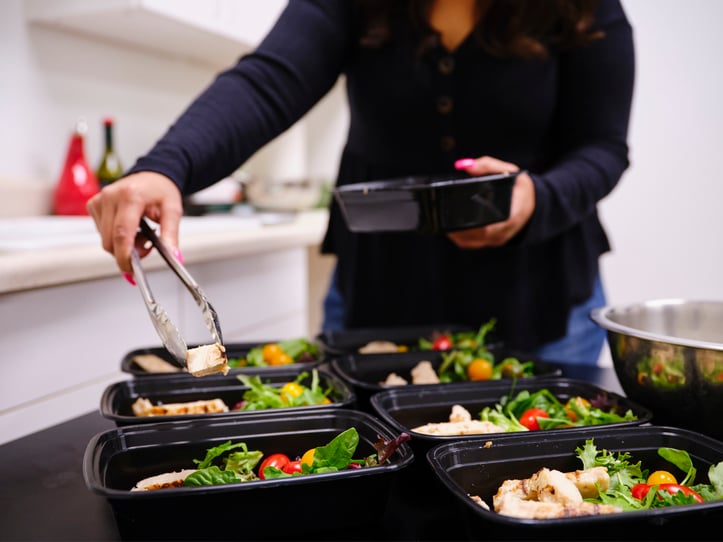New diets are always coming to market. Some of them are brand new while others are simply recycled versions of old diets. Over the past decade one of these diets, the Whole30 Diet, has emerged as a very popular tool for people to use for weight loss and for dealing with health issues.This article will provide an overview of the Whole30 Diet, how to prepare for it, and some of the considerations for people interested in following Whole30.
Diets are an important part of the NASM-CNC curriculum. Check out NASM's nutrition certification course to equip yourself with the necessary nutritional know-how.
What Is the Whole30 Diet?
There are many ways to think about the Whole30 Diet, but when boiled down to its core tenets the Whole30 Diet is a 30-day elimination diet centered around eliminating all processed foods as well as grains, legumes, soy, and dairy. Many people view Whole30 as a form of the Paleo diet, but with more structure and a more set timeframe.
After the initial 30 days of the diet, there are some protocols for slowly reintroducing some of the foods, such as grains and legumes, and seeing how your body responds to them. However, eliminating processed foods remains a core tenet past the initial 30 days.
Tips to Follow the Whole30 Diet
Due to the restrictive nature of Whole30, it can be a difficult diet to follow both initially and long term. If you are going to choose to follow the Whole30 diet there are a few strategies you can implement to improve the likelihood of succeeding, such as: setting up the environment, managing expectations, and planning.
Setting Up the Environment
Many diets succeed or fail based on how successful people can be in setting up their food environment. This holds especially true when following diets that fall on the more restrictive end of the spectrum like Whole30. One of the easiest ways to set up your environment for Whole30 is to do a sweep of your pantry and remove all foods that do not fit within the diet framework.
Eliminating foods from your house reduces the chance you might go off plan when you have cravings or when you might feel tired of your diet. Another way to set up your environment is to minimize or avoid situations that make it difficult to follow your diet. For example, minimizing going out to eat and reducing social gatherings, while difficult, can be effective for ensuring you stay on plan.
Managing Expectations
Just like setting up your physical environment is important, setting up your mental environment is also important for success. Managing your expectations will help individuals navigate the journey that comes with any dieting plan, especially those that may be more restrictive. Going into a diet like Whole30 knowing there will be challenges, there may be days where adherence is mentally difficult, and there may be days or weeks where body weight does not change.
Planning Ahead
“Failing the plan is planning to fail.” Diets like Whole30 are far easier to follow when you plan. Buying groceries in bulk, meal planning, and meal prepping ahead of time can make it much easier to follow the Whole30 diet. Additionally, when you are traveling or plan on eating out at restaurants, packing food with you and/or reviewing menus ahead of time can make it substantially easier to effectively follow Whole30.
How to Prepare for the Whole30 Diet
There are several key things to consider when preparing for the Whole30 Diet. The first is to communicate your goals and plans with your family and a close circle so they can understand that your nutrition habits may change and that it may affect some of the choices that you make; communicating that the choices are not about them, but about your own choices, is also important.
The second is to go grocery shopping and buy foods that fall within the Whole30 framework. Buying fresh fruits and vegetables along with lean meats helps set the framework for success. Also buy convenient foods that you can use in “a pinch” such as frozen fruits and vegetables, or snacks that fall within the Whole30 rules. The third is to look at your calendar and see what social events might derail you and plan for those events.
How to Maintain Your Overall Nutrition After Whole30
One of the major hurdles that people face when following a Whole30 Diet is what to do after the initial 30 days. There are a few tools that people can utilize to help them maintain their overall nutrition after the Whole30 ends. The first is to have an off-ramp plan and not just go from “all-in” on day 30 to “off the wagon” on day 31.
A plan for the transition from a rigid diet structure to a more flexible one is key. The second is to take some of the core principles of the Whole30 diet framework and roll them into your daily life. Here are some of the principles that individuals can take from Whole30 and roll into their lives after the initial 30 days:
● Make whole, unprocessed foods a greater focus in your daily nutrition
● Emphasize fruits and vegetables
● Limit alcohol intake
● Have a plan and structure around your nutrition
Benefits of the Whole30 Diet
While Whole30 may feel restrictive and may not be sustainable over long periods, there are a lot of benefits from utilizing this approach. One benefit is that it can help reshape the way people view food.
Focusing on nutrient-dense, unprocessed foods can help people develop a better understanding of the actual nutrition in food. Another benefit is that adopting a whole, unprocessed food diet can help individuals lower overall calorie intake and lose weight.
Lastly, being able to stick to something for 30 days can help people develop self-efficacy around their nutrition and show them that they can change their habits positively.
Summary
The Whole30 Diet has been a popular weight loss diet over the last several decades and focuses on eliminating processed foods and other food groups such as grains, legumes, soy, and dairy. The diet does have a very strict framework that can be difficult for people to follow without preparation and having a plan for how to handle social situations.
However, there are several benefits to the diet as well. It can be used successfully to lose weight, help teach people about food quality, and help retrain food habits in a relatively short time frame. The Whole30 Diet should be viewed as a tool that may work in some situations but may not work in others.
















